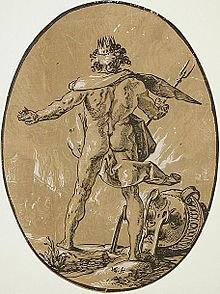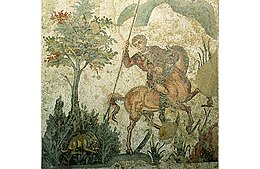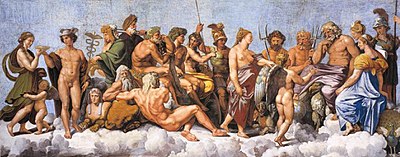
Hades, in the ancient Greek religion and mythology, is the god of the dead and the king of the underworld, with which his name became synonymous. Hades was the eldest son of Cronus and Rhea, although this also made him the last son to be regurgitated by his father. He and his brothers, Zeus and Poseidon, defeated their father's generation of gods, the Titans, and claimed joint rulership over the cosmos. Hades received the underworld, Zeus the sky, and Poseidon the sea, with the solid earth available to all three concurrently. In artistic depictions, Hades is typically portrayed holding a bident and wearing his helm with Cerberus, the three-headed guard-dog of the underworld, standing at his side.

Jupiter, also known as Jove, is the god of the sky and thunder, and king of the gods in ancient Roman religion and mythology. Jupiter was the chief deity of Roman state religion throughout the Republican and Imperial eras, until Christianity became the dominant religion of the Empire. In Roman mythology, he negotiates with Numa Pompilius, the second king of Rome, to establish principles of Roman religion such as offering, or sacrifice.

In Greek mythology, Charon or Kharon is a psychopomp, the ferryman of the Greek underworld. He carries the souls of those who have been given funeral rites across the rivers Acheron and Styx, which separate the worlds of the living and the dead. Archaeology confirms that, in some burials, low-value coins were placed in, on, or near the mouth of the deceased, or next to the cremation urn containing their ashes. This has been taken to confirm that at least some aspects of Charon's mytheme are reflected in some Greek and Roman funeral practices, or else the coins function as a viaticum for the soul's journey. In Virgil's epic poem, Aeneid, the dead who could not pay the fee, and those who had received no funeral rites, had to wander the near shores of the Styx for one hundred years before they were allowed to cross the river. Charon also ferried the living mortals Heracles and Aeneas to the underworld and back again.
In Greco-Roman mythology, Leuce, also spelled Leuke, was a nymph and a daughter of the Titan Oceanus.

In ancient Greek religion and mythology, Plutus is the god and the personification of wealth, and the son of the goddess of agriculture Demeter and the mortal Iasion.

Dis Pater, otherwise known as Rex Infernus or Pluto, is a Roman god of the underworld. Dis was originally associated with fertile agricultural land and mineral wealth, and since those minerals came from underground, he was later equated with the chthonic deities Pluto (Hades) and Orcus.
In ancient Greek religion and mythology, Pluto was the ruler of the Greek underworld. The earlier name for the god was Hades, which became more common as the name of the underworld itself. Pluto represents a more positive concept of the god who presides over the afterlife. Ploutōn was frequently conflated with Ploûtos, the Greek god of wealth, because mineral wealth was found underground, and because as a chthonic god Pluto ruled the deep earth that contained the seeds necessary for a bountiful harvest. The name Ploutōn came into widespread usage with the Eleusinian Mysteries, in which Pluto was venerated as both a stern ruler and a loving husband to Persephone. The couple received souls in the afterlife and are invoked together in religious inscriptions, being referred to as Plouton and as Kore respectively. Hades, by contrast, had few temples and religious practices associated with him, and he is portrayed as the dark and violent abductor of Persephone.

Neptune is the Roman god of freshwater and the sea in Roman religion. He is the counterpart of the Greek god Poseidon. In the Greek-inspired tradition, he is a brother of Jupiter and Pluto; the brothers preside over the realms of heaven, the earthly world, and the seas. Salacia is his wife.

A trident is a three-pronged spear. It is used for spear fishing and historically as a polearm.
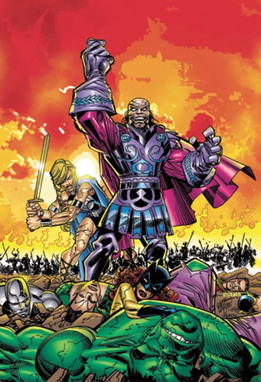
Pluto is a fictional deity appearing in American comic books published by Marvel Comics. The character is based on the Greco-Roman god of the same name.
In ancient Roman myth and literature, Mors is the personification of death equivalent to the Greek Thanatos. The Latin noun for "death," mors, genitive mortis, is of feminine gender, but surviving ancient Roman art is not known to depict death as a woman. Latin poets, however, are bound by the grammatical gender of the word. Horace writes of pallida Mors, "pale Death," who kicks her way into the hovels of the poor and the towers of kings equally. Seneca, for whom Mors is also pale, describes her "eager teeth." Tibullus pictures Mors as black or dark.
A planet symbol or planetary symbol is a graphical symbol used in astrology and astronomy to represent a classical planet or one of the modern planets. The symbols were also used in alchemy to represent the metals associated with the planets, and in calendars for their associated days. The use of these symbols derives from classical Greco-Roman astronomy, although their current altered shapes were developed in the 16th century.
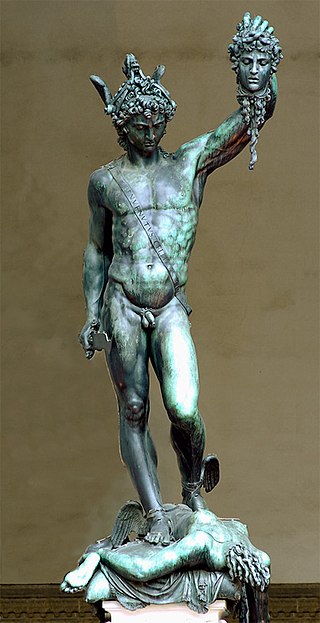
In classical mythology, the Cap of Invisibility is a helmet or cap that can turn the wearer invisible, also known as the Cap of Hades or Helm of Hades. Wearers of the cap in Greek myths include Athena, the goddess of wisdom, the messenger god Hermes, and the hero Perseus. Those wearing the Cap become invisible to other supernatural entities, akin to a cloud of mist sometimes used to remain undetectable.

Hera is a fictional deity appearing in American comic books published by Marvel Comics. The character is based on the Greek Goddess of the same name. Hera first appeared in the pages of Thor #129, written by Stan Lee and drawn by Jack Kirby.

Neptune, also called Poseidon, is a fictional character appearing in American comic books published by Marvel Comics. The character is based on the Roman God with the same name and his Greek counterpart. Neptune is the god of the sea in the Olympian pantheon, and the patron god of Atlantis. Neptune first appeared in Tales to Astonish #70 and was adapted by Stan Lee and Gene Colan.

Typhon is a fictional character appearing in American comic books published by Marvel Comics. The character is most commonly associated with the hero Hercules. He is based on the legendary monster of the same name.

Saturn was a god in ancient Roman religion, and a character in Roman mythology. He was described as a god of time, generation, dissolution, abundance, wealth, agriculture, periodic renewal and liberation. Saturn's mythological reign was depicted as a Golden Age of abundance and peace. After the Roman conquest of Greece, he was conflated with the Greek Titan Cronus. Saturn's consort was his sister Ops, with whom he fathered Jupiter, Neptune, Pluto, Juno, Ceres and Vesta.
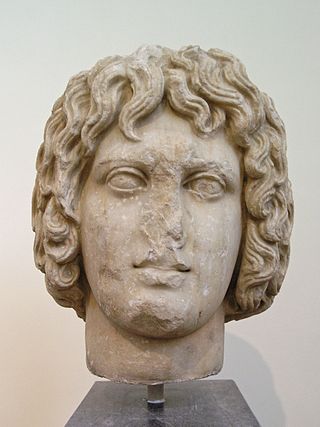
In ancient Greek religion and myth, Eubuleus is a god known primarily from devotional inscriptions for mystery religions. The name appears several times in the corpus of the so-called Orphic gold tablets spelled variously, with forms including Euboulos, Eubouleos and Eubolos. It may be an epithet of the central Orphic god, Dionysus or Zagreus, or of Zeus in an unusual association with the Eleusinian Mysteries. Scholars of the late 20th and early 21st centuries have begun to consider Eubuleus independently as "a major god" of the mysteries, based on his prominence in the inscriptional evidence. His depiction in art as a torchbearer suggests that his role was to lead the way back from the Underworld.

The trident of Poseidon and his Roman equivalent, Neptune, has been their traditional divine attribute in many ancient depictions. Poseidon's trident was crafted by the Cyclopes.
